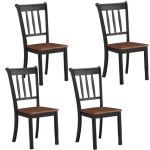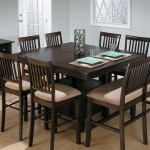Antique Drop Leaf Kitchen Tables: A Timeless Blend of Function and Style
Antique drop leaf kitchen tables represent a significant piece of furniture history, embodying practicality and aesthetic appeal. These tables, prized for their versatility and space-saving design, were a staple in homes from the 18th century onwards. Their enduring popularity stems from their ability to adapt to various needs, making them a valuable addition to both small and large kitchens alike. Understanding the history, construction, identifying features, and care requirements of antique drop leaf kitchen tables is essential for collectors, enthusiasts, and anyone seeking to incorporate a touch of historical elegance into their modern living space.
The very essence of a drop leaf table lies in its design. It features one or more hinged leaves that can be lowered or raised, allowing the table to be compactly stored or expanded to accommodate more people. When both leaves are down, the table can be pushed against a wall, occupying minimal floor space. When raised, the leaves provide a significantly larger surface for dining, food preparation, or other activities. This adaptable functionality made drop leaf tables particularly desirable in a time when homes were often smaller and space was at a premium.
Evolution and Historical Context
The evolution of the drop leaf table can be traced back to earlier gateleg tables of the 17th century. The gateleg employed hinged legs that swung out to support the dropped leaves. While functional, gateleg tables could be cumbersome and less stable than later designs. The drop leaf table, as we recognize it today, improved upon this design by incorporating various support systems, such as pivoting brackets or pull-out slides, providing greater stability and a cleaner aesthetic. These advancements occurred primarily during the 18th century, coinciding with the rise of more sophisticated furniture-making techniques.
During the 18th and 19th centuries, drop leaf tables became increasingly prevalent in both Europe and America. In England, they were often crafted from hardwoods such as oak, walnut, and mahogany, reflecting the availability of timber and prevailing stylistic trends. American drop leaf tables often utilized maple, cherry, and pine, reflecting the locally sourced materials. The style of the table often mirrored the dominant furniture style of the period. For example, Queen Anne drop leaf tables featured cabriole legs and graceful curves, while Federal-style tables incorporated delicate inlay and tapered legs. Victorian-era drop leaf tables were often more ornate, showcasing elaborate carvings and heavier proportions.
The 20th century saw a continued demand for drop leaf tables, particularly in smaller homes and apartments. While antique examples remained popular, new versions were produced using a wider range of materials, including plywood and laminate. Mid-century modern drop leaf tables often featured clean lines, minimalist designs, and materials like teak and chrome. Although later examples may hold less monetary value than earlier, handcrafted antiques, they still represent a continuation of the design's enduring appeal and adaptability.
Identifying Features and Construction
Several key features aid in identifying and dating antique drop leaf kitchen tables. These include the type of wood used, the style of legs, the hardware, and the overall construction techniques employed. A close examination of these elements can provide valuable clues about the table's origin and age.
Wood Type: As previously mentioned, the type of wood is a crucial indicator. Earlier tables, especially those dating from the 18th and early 19th centuries, were typically made from solid hardwoods. The presence of pine as a secondary wood, used for drawer bottoms or interior supports, is common in American furniture. Examining the grain pattern and finish can further assist in identification. For example, mahogany often exhibits a rich, reddish-brown hue and a distinctive grain pattern, while oak typically displays a prominent, open grain.
Leg Style: The style of the legs is another important identifying feature. Cabriole legs, characterized by their S-shaped curve, are commonly found on Queen Anne and Chippendale-style tables. Tapered legs, which narrow towards the bottom, are typical of Federal and Hepplewhite designs. Turned legs, created on a lathe, were used on a wide range of tables from various periods. The presence of stretchers, horizontal supports connecting the legs, can also provide clues. Earlier tables often had stretchers for added stability, while later examples might omit them.
Hardware: The hardware, including hinges, latches, and drawer pulls, can be highly informative. Hand-forged hinges and hand-cut dovetails are indicative of earlier craftsmanship. The style of the drawer pulls, whether brass, iron, or ceramic, also reflects the period in which the table was made. Examining the hardware for signs of wear and patina can provide insights into the table's age and usage.
Construction Techniques: Observing the construction techniques employed is essential. Hand-cut dovetails, mortise-and-tenon joints, and the absence of machine-made elements are hallmarks of earlier, handcrafted furniture. The presence of saw marks, tool marks, and minor imperfections can also indicate hand craftsmanship. Conversely, the presence of perfectly uniform joints and machine-made hardware suggests a later manufacture date.
Care and Restoration Considerations
Preserving antique drop leaf kitchen tables requires careful attention to their unique needs. Proper care and restoration techniques can ensure that these valuable pieces of furniture endure for generations to come. Understanding the potential pitfalls of improper restoration is equally important.
Cleaning and Maintenance: Regular cleaning is essential to prevent the buildup of dust and grime. A soft cloth, dampened with a mild soap and water solution, is generally sufficient for cleaning the surface. Avoid using harsh chemicals or abrasive cleaners, as these can damage the finish. Applying a high-quality furniture polish occasionally can help to protect the wood and enhance its luster. It is also important to protect the table from excessive moisture and sunlight, which can cause warping, fading, and cracking.
Repairing Minor Damage: Minor scratches and blemishes can often be repaired with touch-up markers or wax sticks designed for furniture repair. Loose joints can be tightened with wood glue and clamps. However, more extensive repairs, such as replacing missing veneer or repairing structural damage, should be entrusted to a qualified furniture restorer. Incorrectly repairing or refinishing an antique can diminish its value and authenticity.
Refinishing Considerations: Refinishing an antique drop leaf table is a complex process that should only be undertaken when absolutely necessary. Before refinishing, carefully assess the existing finish to determine its original type and condition. Stripping the old finish requires caution, as harsh chemicals can damage the wood. When applying a new finish, choose a product that is compatible with the wood and appropriate for the table's intended use. It is also important to consider the historical accuracy of the finish. For example, using a modern polyurethane finish on an 18th-century table would be stylistically inappropriate and could detract from its value.
Professional Restoration: In cases of significant damage or extensive restoration needs, it is advisable to consult with a professional furniture restorer. A skilled restorer can assess the table's condition, recommend appropriate treatment options, and execute the restoration work with expertise and care. Choosing a restorer with experience in antique furniture is crucial, as they will understand the importance of preserving the table's original character and value. They will also be knowledgeable about the proper techniques and materials to use for restoration, ensuring that the table is returned to its former glory without compromising its historical integrity.
In conclusion, antique drop leaf kitchen tables represent not only functional furniture but also tangible links to the past. Their enduring popularity reflects their versatility, adaptability, and timeless aesthetic appeal. By understanding their history, identifying features, and care requirements, collectors, enthusiasts, and homeowners can appreciate and preserve these valuable pieces of furniture for generations to come. The antique drop leaf kitchen table continues to serve as a beautiful and practical addition to any home, bridging the gap between history and modern living.

Antique Drop Leaf Table Wood Furniture Dining Farmhouse Kitchen Solid Etsy

Antique Drop Leaf Table Silverware Drawers Wood Furniture Dining Gate Leg Harvest Farmhouse Kitchen Solid Etsy

Antique Drop Leaf Cottage Dining Table In Pine

Antique Drop Leaf Table Wood Furniture Dining Farmhouse Kitchen Solid Etsy

Amish Drop Leaf Dining Table

Antique Drop Leaf Table Silverware Drawer Wood Furniture Dining With Wheels Farmhouse Kitchen Solid Etsy

Antique Solid Mahogany Drop Leaf Table With Pedestal Base Carved Claw Feet Long Valley Traders

Antique Drop Leaf Table

19th Century Pine Drop Leaf Kitchen Table For Sale At Pamono

Restored Antique Mahogany Drop Leaf Dining Table
See Also








